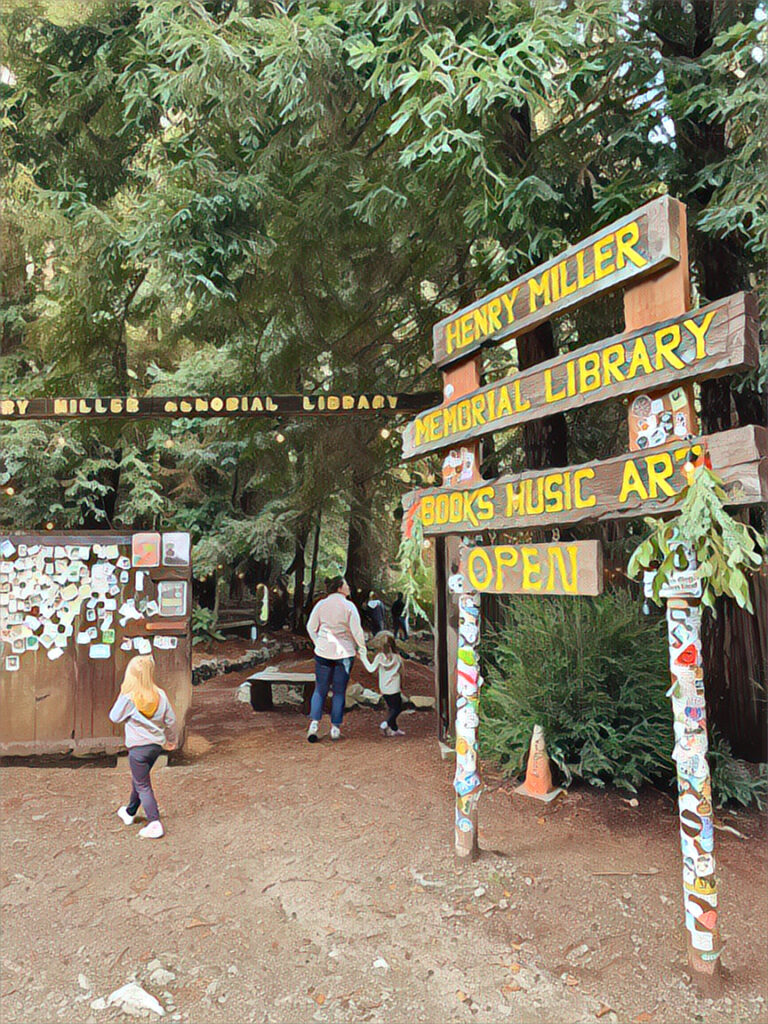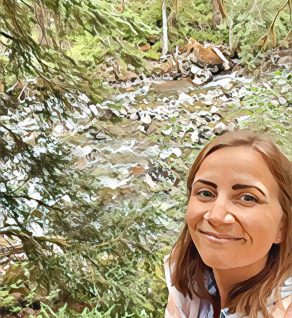This post contains affiliate links
On a recent trip to Big Sur with a friend and my daughters, I was finally able to visit the Henry Miller Library which had intrigued me since I first saw it many years ago. We just finished lunch at Nepenthe (go for the incredible views, not particularly for the food) and headed south to find the purple sands of Pfeiffer Beach. We passed by the library just a quarter mile south of Nepenthe and I made a mental note to stop on our return north.
Twenty minutes later, we realized we weren’t going to find this beach. I mistakenly thought it was across from Julia Pfeiffer Burns State Park and, well, the beach is actually across from Pfeiffer Big Sur State Park 9.5 miles north (because names matter) so we turned around and reversed course. This time, as I approached the twinkling market lights and sticker tagged sign, I pulled in. According to the website, the library is where “nothing happens.” Doubtful, given all of the other cars pulled over in the small parking lot.
A SMALL HISTORY OF HENRY MILLER
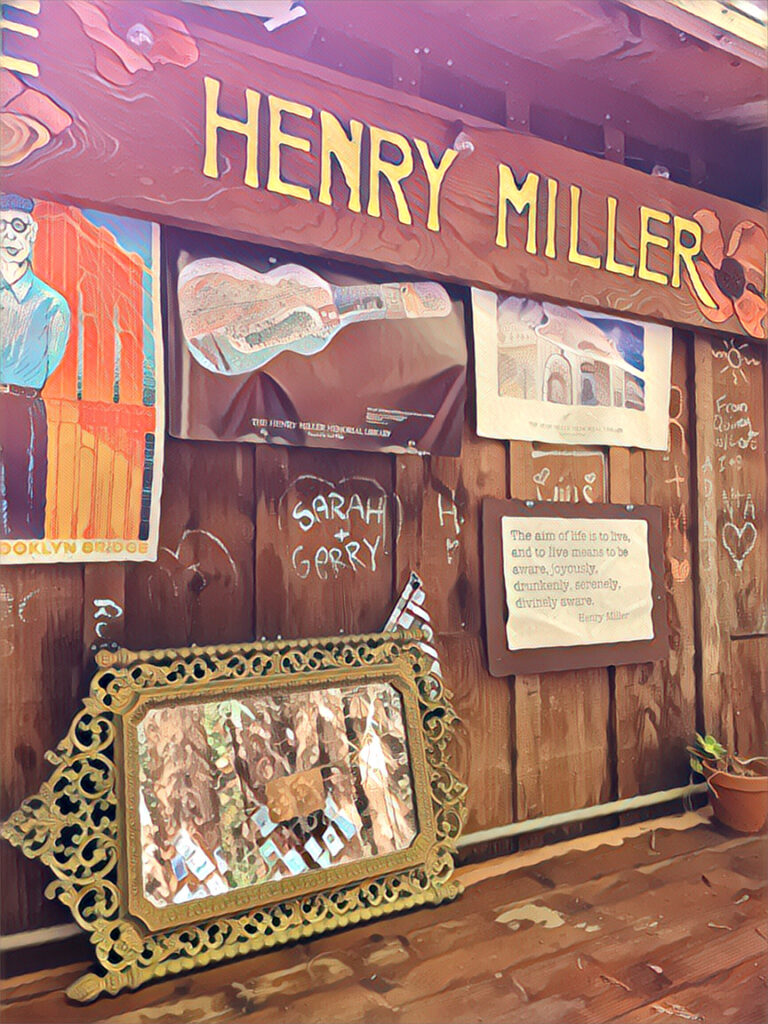
I’m slightly embarrassed that my breadth of knowledge of Henry Miller up to this point went as far to say he was a writer and an artist. After thorough research (thanks wiki) I now know he was an absolute creative powerhouse. Born in New York City in 1891 to American parents of German descent, Miller spent little time in Manhattan before moving to Brooklyn. He would move around various neighborhoods in the area through young adulthood and worked as a manager at Western Union before leaving to focus on his writing career. It was also during this time he would marry twice.
After 1930, Miller moved to Paris with his second wife, June, for nearly a decade. While there, Miller worked as a proofreader for the Paris outfit of The Chicago Tribune. Like a lot of other early 20th Century writers, Miller found his fountain of creativity while living in Paris. He met British author, Lawrence Durrell, and sparked a life-long friendship.
Miller published his first book Tropic of Cancer in 1934. This was followed by Black Spring in 1936 and Tropic of Capricorn in 1939. However, all of these books were banned in the US due to their lurid details of various sexual experiences and even came with warnings on book jackets prohibiting import to the US or England.
The early 1940s would bring Miller back to the US. He began a year-long tour around the country which provided inspiration for The Air-Conditioned Nightmare–a memoir that follows Miller’s trip and details his disgust with American consumerism and the stifling of its creative citizens. One occurrence during this time was a night’s stay with friends who were also hosting painter Salvador Dalí and his wife. Miller notes his dislike of Dalí because he felt him to be too vain.
In 1942 he settled in Los Angeles and created hundreds of watercolor paintings that were well received at exhibits in Beverly Glen and Hollywood. It wasn’t until 1944 that Miller moved to Big Sur and declared it his first “real home in America.” During this part of his life he would marry three more times (the youngest of his wives being 37 years his junior), father children, and work on pieces that would make up The Rosy Crucifixion trilogy and Big Sur and the Oranges of Hieronymus Bosch.
Because of the obscene nature of Miller’s work and the subsequent banning of his books, they were often smuggled into the US. This caught the eye and proved to be a big influence on Beat Generation writers, particularly Jack Kuerouac (who would eventually be the only Beat that Miller had a close relationship with). Dare I say Miller was the grandfather to the Beat Generation?
Miller stayed in California until his death in 1980. When he was in his 80s, he filmed Reds with Warren Beatty. It was one of his last projects. During the last four years of his life he also exchanged some 1,500 “pen pal” letters with Playboy model, actress, ballerina, and author, Brenda Venus. Venus had purchased a book at auction that had an envelope with the name and address of Miller in it and thus created this years-long friendship. Venus was Miller’s muse when she was a mere 24 years of age–and he was 84.
WHAT TO EXPERIENCE AT THE HENRY MILLER LIBRARY
Once we left the car, it all started to feel dreamlike. This portion of Highway 1 runs deep through redwoods so as soon as you enter into the property you’re under the canopy of old growth trees. It had pounded rain the day before so everything was damp and the crisp scent of the redwoods and earth cleared the mind.
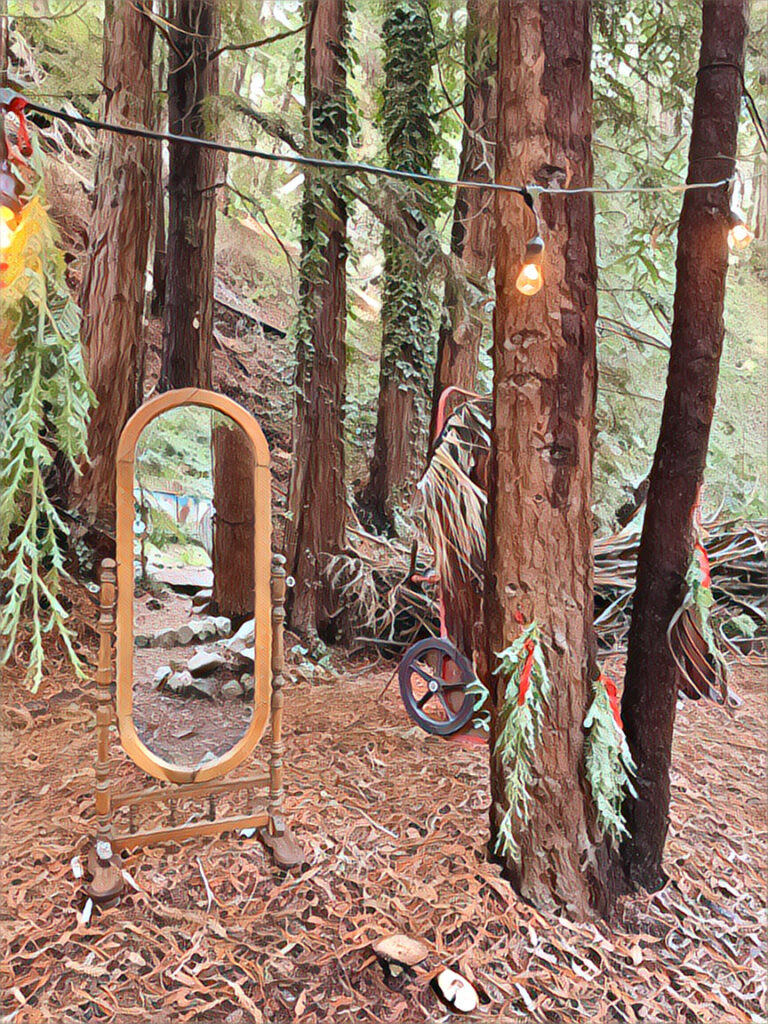
Walking toward the building we first came across a handful of weathered art installations–stacked vintage computers in the shape of a cross, a solitary mirror, a decrepit, rotting piano, some rusted antique typewriters. The path opens to a large grassy area with a stage to one side and the main building just in front of you.
Climbing the stairs to the porch, there are dozens of individual books in clear plastic casings hanging from the eaves of the roof and attached to the side of the building almost like ornaments on a tree. I couldn’t yet see inside but the sliding glass was open just enough to fit my body through so I sidestepped in and was in complete awe.
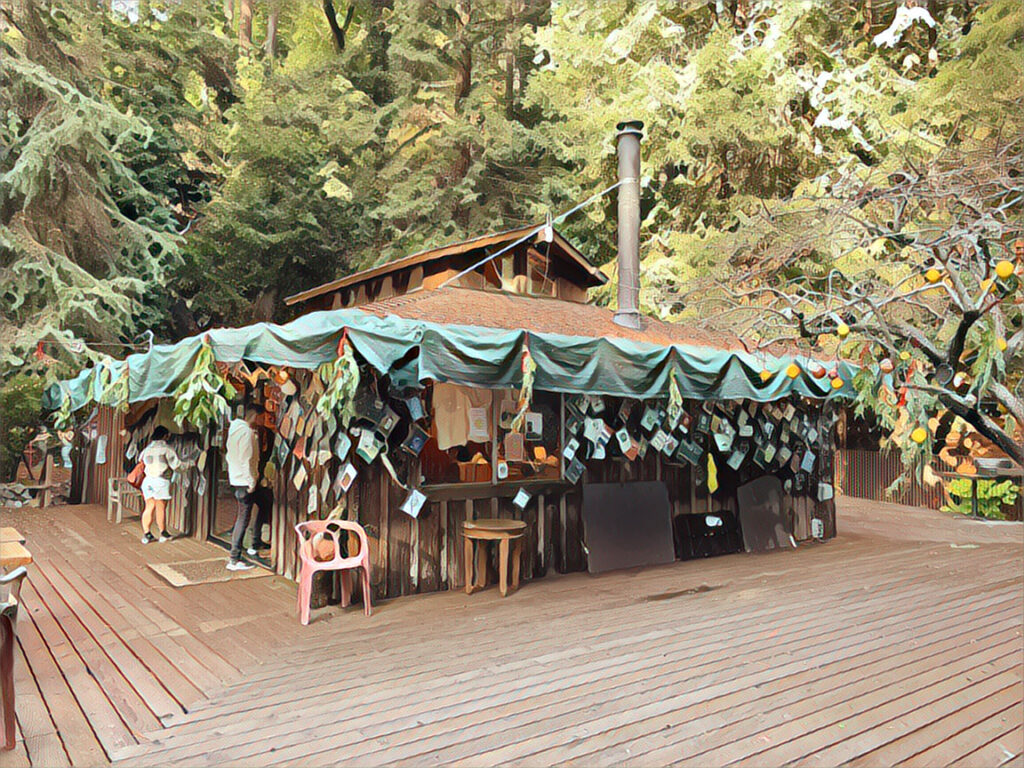
One of the elements that makes a good bookstore (spoiler alert–the Henry Miller Library is really a bookstore) for me is if it makes me feel cozy. Walking into the Henry Miller Library made me feel like I was stepping into a warm embrace (mind you, this was in December). What I noticed first was a small wreath of flickering taper candles on the checkout counter–how daring!–and the intoxicating smell of a wood burner. I let my eyes take in the small space. Foreign bank notes hang in sheets from the ceiling, books do in other spaces.
There are vintage typewriters strewn about welcoming you to type a note. A soft green couch. An eclectic collection of photos hung on the walls, support beams, and ceiling. A guitar casually resting. And so many books on shelves and stacked and displayed on mismatched tables throughout.
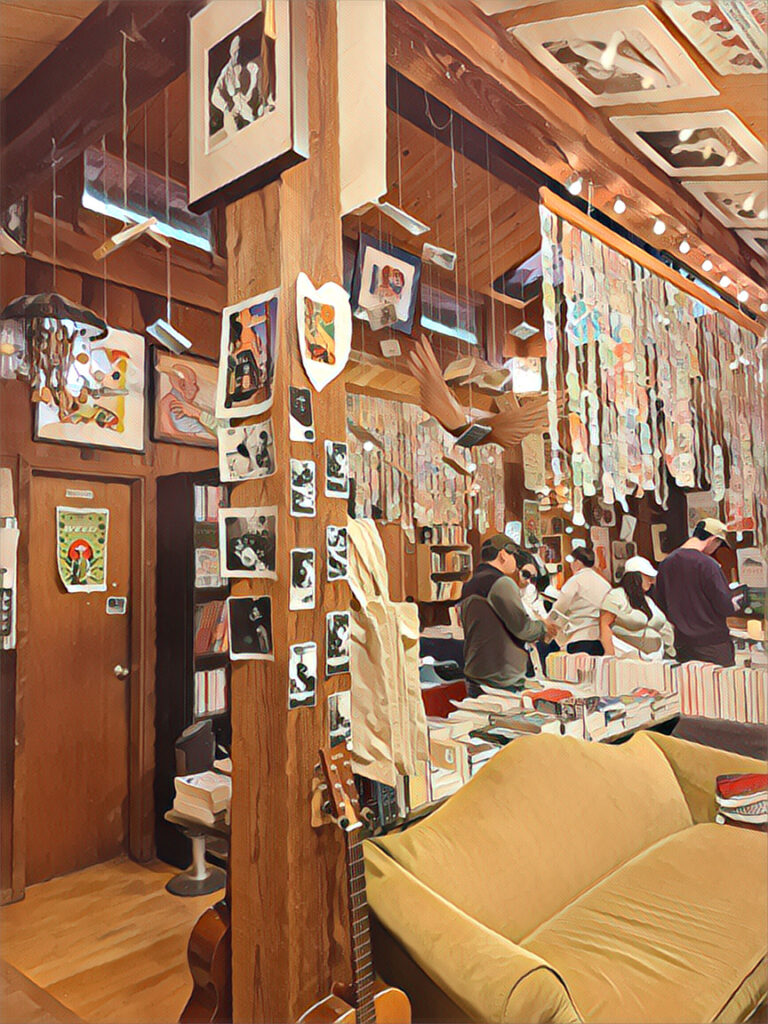
I felt like I was in someone’s well loved den rather than a bookstore. Which makes sense as this was originally a property built by Emil White for Miller in the 60s. After Miller’s death in 1980, White requested that the house be used as a memorial to Miller and a space where local artists could exhibit their work. At this point, I wasn’t sure if I’d come across any books that were there for the taking as long as they were returned in good condition like an actual library but there was an eclectic assortment available for purchase.
All of Miller’s body of work, of course, as well as books by Beat writers such as Jack Kerouac, Ken Kesey, and Allen Ginsberg. There was a small but lovely children’s section. And a large selection of books by the likes of Thich Nhat Hanh and other meditation and spiritual gurus. This non-profit is more than a bookstore–it serves as a space for performances, indie film festivals, and one for local writers, artists and throngs of tourists to come together and, well, do nothing. I left with a copy of Jack Kerouac’s Big Sur. It seemed appropriate for our trip.
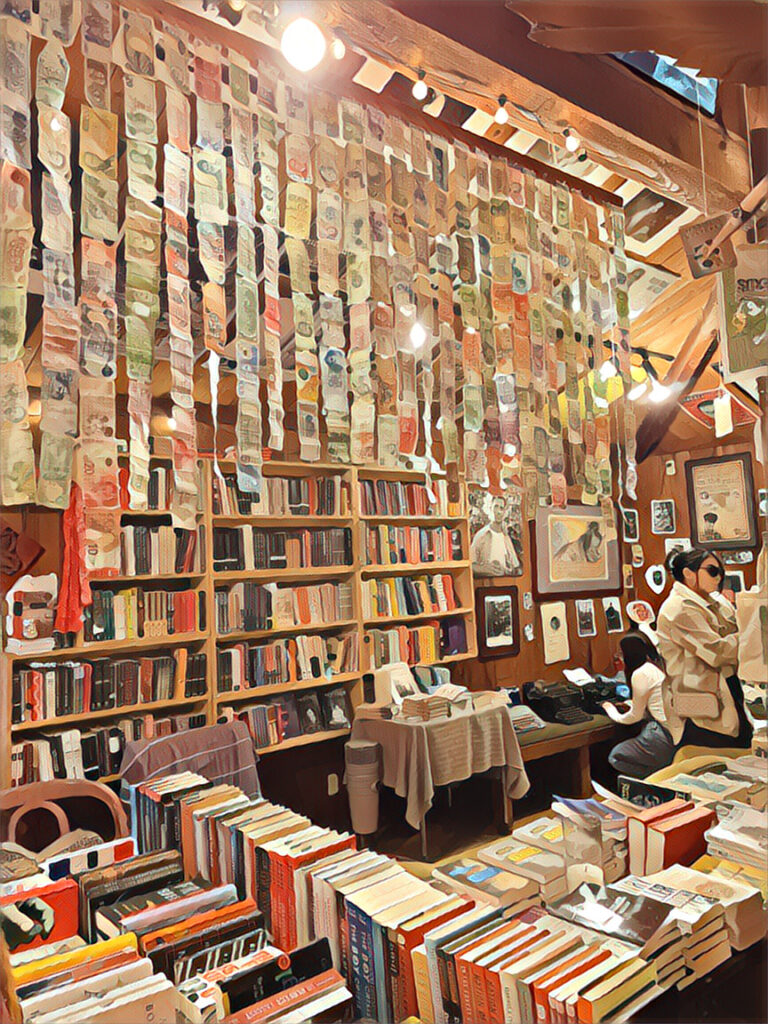
After I exited the building, I walked around the exterior. Past travelers used chalk to mark their names and visits on the wooden siding. There were small figurines and framed Miller quotes scattered about. There was seasonal decor made up of clementines and ribbons hanging from a lone tree on the deck. Looking out into the old growth forest beyond the back of the house, the world seemed infinite.
My friend and I kept saying that it seemed like one of those places that might disappear after you exit, leaving you to wonder if it ever existed at all. The Henry Miller Memorial Library was truly special and I cannot wait to return.
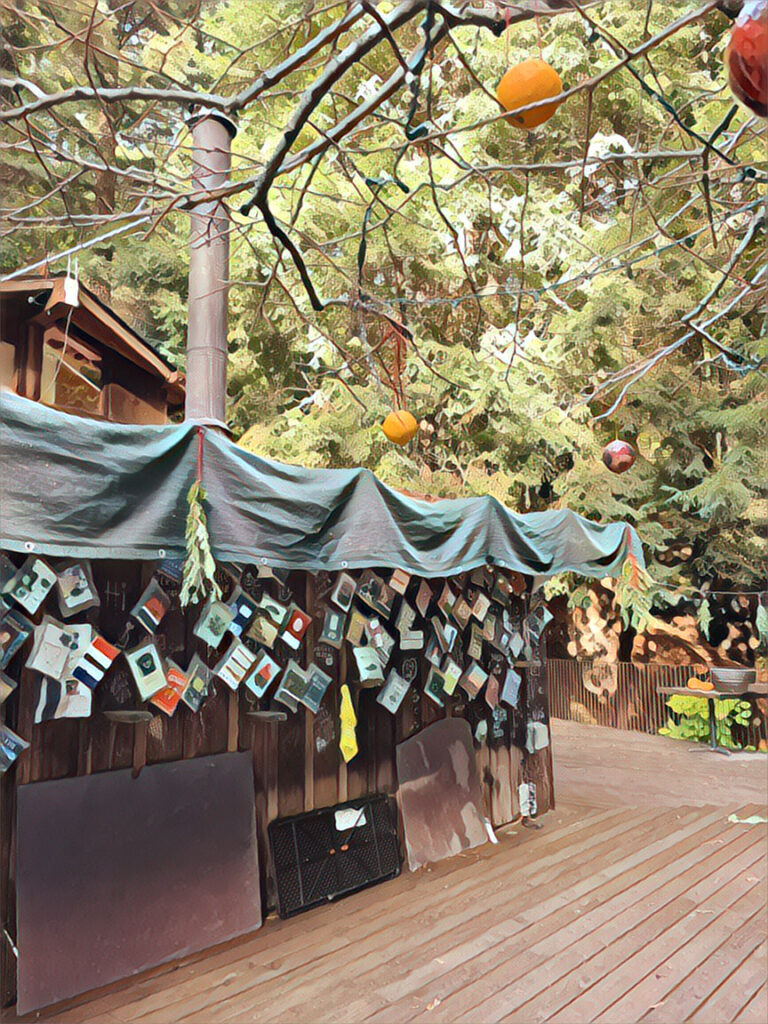
KNOW BEFORE YOU GO
The Henry Miller Memorial Library is located on Highway 1 in Big Sur. You can use 48603 CA-1 for your GPS device. Parking can be tricky–like most spots in Big Sur there is a very small gravel parking lot just off the side of the road in front of the main entrance. The entire lot probably fits about 10 cars.
The library is open six days a week (except Tuesdays) from 11am-5pm PCT. If you go during the rainy season, make sure to check the Caltrans site for road closures, as Highway 1 often closes in inclement weather. The bookstore accepts credit cards and apple pay as well as cash and there is a small restroom on site. It is free to enter.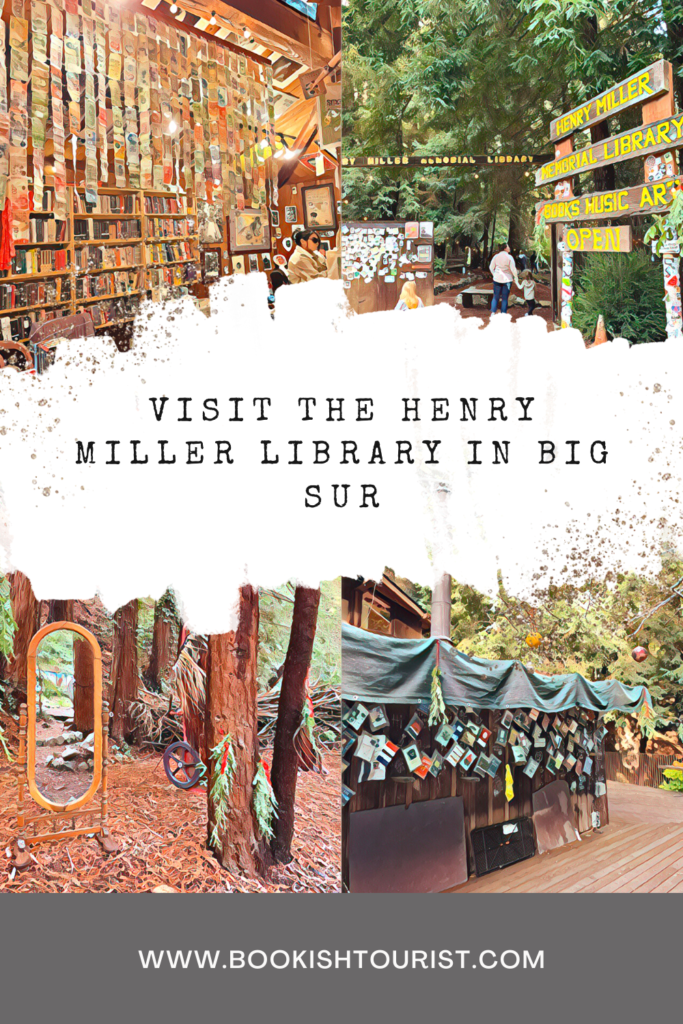
Have you been to the Henry Miller library? Let me know what you thought in the comments. If you’re headed down to Los Angeles after Big Sur, don’t forget to visit the historic LA Central Public Library!
